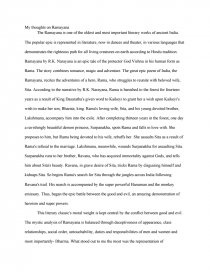Ramayana Case
Essay by people • March 8, 2012 • Essay • 593 Words (3 Pages) • 1,382 Views
My thoughts on Ramayana
The Ramayana is one of the oldest and most important literary works of ancient India. The popular epic is represented in literature, now in dances and theater, in various languages that demonstrates the righteous path for all living creatures on earth according to Hindu tradition. Ramayana by R.K. Narayana is an epic tale of the protector God Vishnu in his human form as Rama. The story combines romance, magic and adventure. The great epic poem of India, the Ramayana, recites the adventures of a hero, Rama, who struggles to reunite with beloved wife, Sita. According to the narrative by R.K. Narayana, Rama is banished to the forest for fourteen years as a result of King Dasaratha's given word to Kaikeyi to grant her a wish upon Kaikeyi's wish to make her son, Bharata, king. Rama's loving wife, Sita, and his young devoted brother, Lakshmana, accompany him into the exile. After completing thirteen years in the forest, one day a ravishingly beautiful demon princess, Surpanakha, spots Rama and falls in love with. She proposes to him, but Rama being devoted to his wife, rebuffs her. She assaults Sita as a result of Rama's refusal to the marriage. Lakshmana, meanwhile, wounds Surpanakha for assaulting Sita. Surpanakha runs to her brother, Ravana, who has acquired immortality against Gods, and tells him about Sita's beauty. Ravana, in grave desire of Sita, tricks Rama by disguising himself and kidnaps Sita. So begins Rama's search for Sita through the jungles across India following Ravana's trail. His search is accompanied by the super powerful Hanuman and the monkey emissary. Thus, began the epic battle between the good and evil, an amazing demonstration of heroism and super powers.
This literary classic's moral weight is kept central by the conflict between good and evil. The mystic analysis of Ramayana is balanced through deceptiveness of appearance, class relationships, social order, untouchability, duties and responsibilities of men and women and most importantly- Dharma. What stood out to me the most was the representation of relationships among humans whether it be with each other or the society. However, the same "ideal-ness" of characters in Ramayana created doubts in my mind. Focusing on Rama himself, he is called the great one or the ideal one (Maryada Purushottama). His life never deviated from the norm of Dharma. The touchstone of human excellence, Dharma, led Rama's life. In fact, it was due to Dharma that smilingly made Rama depart to forest for exile. However, Dharma did create tensions. And can Dharma really be categorized as human excellence when it strains human relationships based on societal influences. Yes, I'm talking about Sita. According to me, Rama questioning Sita on her integrity violated the norms of him being the "ideal" one. Later on, driving Sita out of his kingdom simply not to let a
...
...

